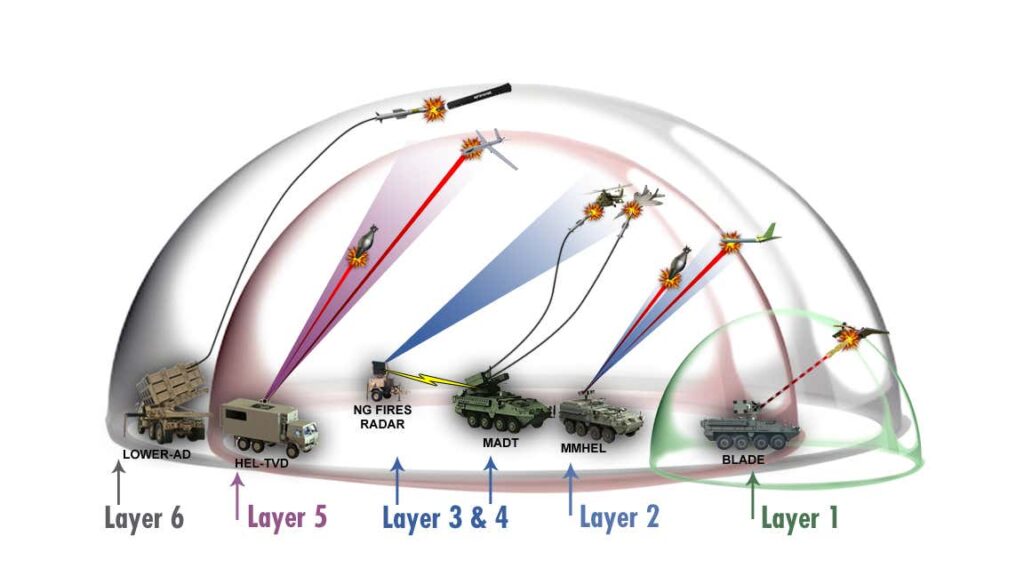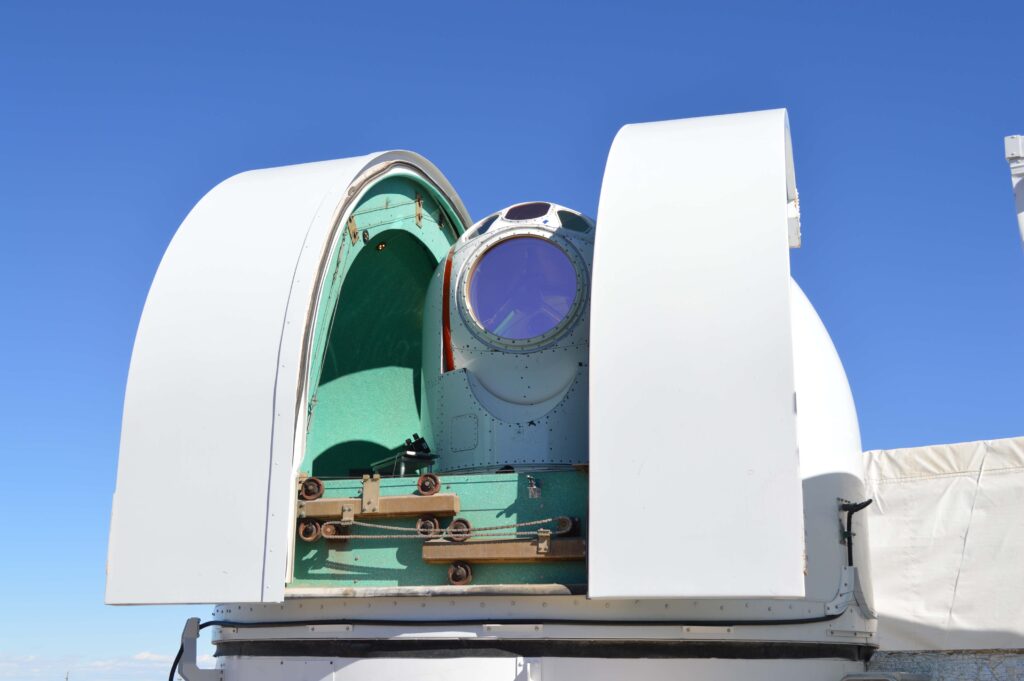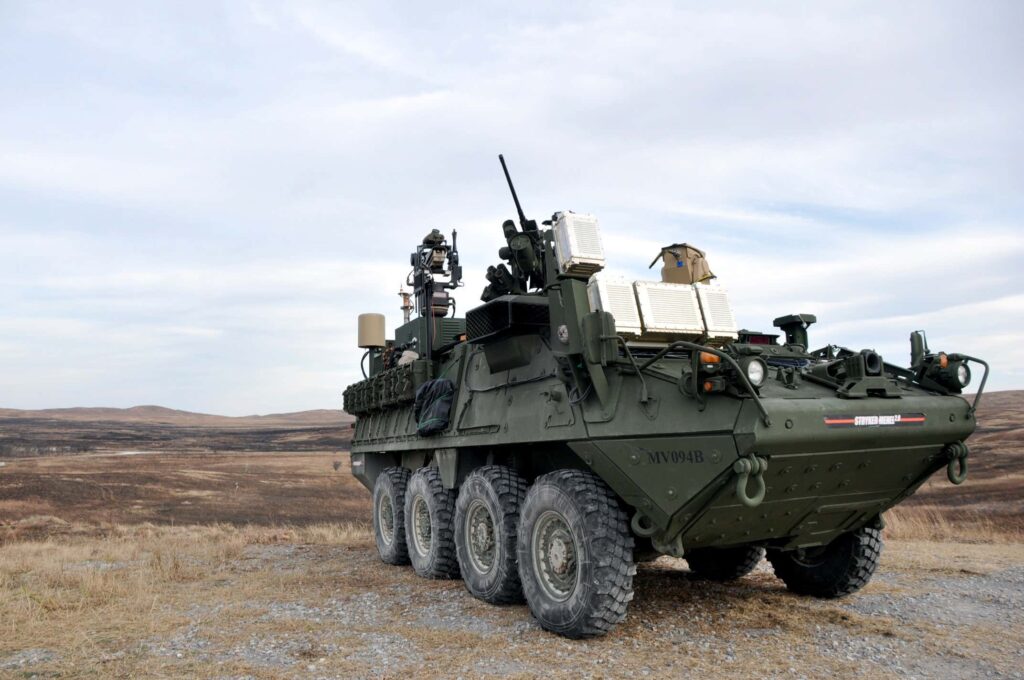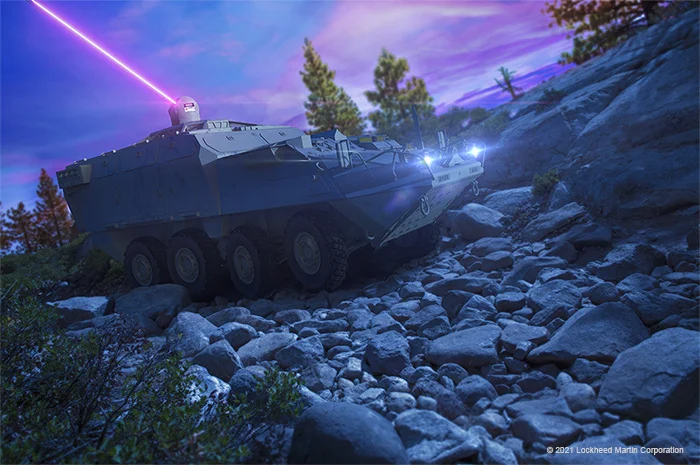Death beams and ray guns may be science fiction staples, but the idea of directed energy weapons (DEWs) was around long before Captain Kirk boldly went anywhere, or anyone named Skywalker ever thought to pick up a lightsaber. Now, as DEWs look close to becoming reality, the next question to ask is: If for every measure there is a countermeasure, what counters direct energy? Could it be the forcefield?
The Air Force Research Laboratory at Kirtland Air Force Base has released a new analysis of the Department of Defense’s investments into directed energy technologies, or DE. The report, titled “Directed Energy Futures 2060,” makes predictions about what the state of DE weapons and applications will be 40 years from now and offers a range of scenarios in which the United States might find itself either leading the field in DE or lagging behind peer-state adversaries. In examining the current state of the art of this relatively new class of weapons, the authors claim that the world has reached a “tipping point” in which directed energy is now critical to successful military operations.
One of the document’s most eyebrow-raising predictions is that a “force field” could be created by “a sufficiently large fleet or constellation of high-altitude DEW systems” that could provide a “missile defense umbrella, as part of a layered defense system, if such concepts prove affordable and necessary.” The report cites several existing examples of what it calls “force fields,” including the Active Denial System, or “pain ray,” as well as non-kinetic counter-drone systems, and potentially counter-missile systems, that use high-power microwaves to disable or destroy their targets. Most intriguingly, the press release claims that “the concept of a DE weapon creating a localized force field may be just on the horizon.”
In a press release accompanying the document, AFRL’s Directed Energy Deputy Chief Scientist Jeremy Murray-Krezan adds that current directed energy technology is “not quite Star Wars,” but adds that the AFRL is “getting close.” The document describes advances occurring both in the private sector and the Department of Defense that are driving the size and weight of DE systems down while increasing power, making the kinds of weapons dreamed about in science fiction seem more like reality. The authors describe the concept in more detail:
The “holy grail” from a military utility perspective is a DE weapon system effective enough, favorable from a SWAP perspective, and affordable enough to provide a nuclear/missile umbrella. Although a concept often associated with science fiction, in fact ground and ship-based DE defense systems effectively act like point-localized force fields against small and relatively soft targets today. Airborne and space-based DE platforms could achieve a greater area defense and multipoint defenses, for a broader coverage missile umbrella.
“By 2060 we can predict that DE systems will become more effective, and this idea of a force field includes methods to destroy other threats too,” Murray-Krezan said in the press release. “Eventually there may be potential to achieve the penultimate goal of a Nuclear or ballistic missile umbrella. It’s fun to think about what that might be in 2060, but we don’t want to speculate too much.”

However, in the full report, the authors point out that “these concepts require significant technical advancement by 2060 to achieve the full range of power contemplated.”
Murray-Krezan states in the accompanying press release that the document was intended to be somewhat of a thought experiment, but one based on current trends. “We’re painting with broad strokes, but we’re diving into what missions of the future will look like,” said Murray-Krezan. “DE is uniquely suited for an area of growing importance, nondestructive but damaging, disruptive, and denial of operations,” Murray-Krezan said. “Not every military operation has to result in a smoking hole in the ground for it to be successful.”

The report was written by the AFRL’s Office of the Chief Scientist for DE for the Office of the U.S. Secretary of Defense’s Directed Energy Community of Interest. Contributions were also made by the Naval Research Laboratory, U.S. Army Space and Missile Defense Command, the Joint Intermediate Force Capabilities Office, Los Alamos, Sandia, and Lawrence Livermore National Laboratories, and a variety of partners in academia, the private sector, and NATO affiliated allies.
In the press release accompanying the report, AFRL states that the document was intended to “bring together some of the most innovative thinkers in DE to build a plan to keep our warfighters and our country safe.” The document defines directed energy as “a focused beam of electro-magnetic energy that is used to enable or create military effects, when used in conjunction with other military systems, including kinetic weapons.” Several different types of DE systems are cited in this definition including are lasers, radio frequency devices, high power microwave, millimeter wave, and particle beams. The report states that these can be used to create at least five different military effects: “deny, degrade, damage, destroy, or deceive.”

Among the report’s key findings is that “due to the convergence of trends in technology and the evolution of the battlefield, DE military capabilities have reached or passed a tipping point in their criticality to the successful execution of cross-domain, military operations by the U.S., Allies, and current and potential rivals and adversaries.” The report also adds that these peer-state rivals are “challenging U.S. leadership in military DE capabilities” but that the AFRL is “moving aggressively to retain U.S. DE leadership.”
A recent primer on directed energy technologies published by the Congressional Research Service (CRS) notes a few examples of these peer adversary capabilities, including anti-satellite microwave weapons being developed in Russia and China. The CRS adds that “Some analysts have questioned whether DOD has sufficient knowledge of adversary DE weapons systems and materials to develop its weapons requirements.”
The AFRL report claims that the proliferation and advancement of DE technologies among superpowers will be driven by three pressing military needs:
• Information superiority operations that promise control of the electromagnetic spectrum. Electromagnetic spectrum superiority in a conflict requires EW or DE weaponry.
• Capability to project military power faster, at longer stand-off ranges, and efficiently, as part of an integrated layered defense which includes command and control, ISR, cyber, and kinetic weapons.
• Unique, intermediate force, special operations, and potentially space-based missions that require flexibility, scalability, and precision effects across all domains and phases of conflict.
The report’s authors argue that U.S. military leadership should instead remember the costly arms races of the Cold War and understand that “technological and military investment can drive national costs to unacceptable levels.” To ensure this doesn’t happen, the authors note that “there must be continued assessment of DE’s value.”

The idea of a force field is still a flight of fantasy, but heavier-than-air flight was also considered by some mainstream scientists to be a crazy idea only a little more than a century ago. There is also the reality that much of what is being developed on the cutting-edge in the directed energy space remains classified.
Still, from all indications, we’re still a ways away from being able to fully realize these types of directed energy capabilities, but the Air Force Research Laboratory and other labs are clearly trying to envision future applications of more advanced versions of current DE concepts. It may be a stretch to call an automated high-powered microwave counter-drone system a “force field,” but at least some parallels can be drawn between the concepts. In fact, if such a system were built to be omnidirectional in nature, it would perform a bit like a force field as we see it in science fiction. Regardless, for a good primer of what is possible now and what is possible in the future when it comes to directed energy, check out this in-depth interview of ours.
Ultimately, this new report by the AFRL shows just show promising directed energy capabilities are finally becoming to the battlefield of today, forcefields or not. If we have indeed already crossed the “tipping point” claimed in the article, the wars of the future are certainly going to resemble what has previously been seen only in science fiction.
Lockheed Unveils New Laser Weapon for U.S. Army

Lockheed Martin has already started building a new laser weapon for Stryker combat vehicles in anticipation for a future competition for the US Army’s short range air defense system, the company announced Monday.
They are designing a 50 kilowatt laser called DEIMOS, short for Directed Energy Interceptor for Maneuver of Short Range Air Defense, said Tyler Griffin, Lockheed’s director of laser and sensor systems.
“We see a competition for a program of record on the horizon. The [Army’s Rapid Capabilities and Critical Technologies Office] and [Program Executive Office] Missiles and Space have been very clear about that,” he said, adding that the competition could occur as early as 2023.
Lockheed hopes to unseat an incumbent team of Raytheon and Kord Technologies, which received a $123.9 million contract this summer to build a Directed Energy Maneuver Short Range Air Defense system (DE M-SHORAD) from the Army after their prototype completed a shoot out earlier this year.
Under that contract, the companies are tasked to build three additional laser systems that will be integrated onboard Stryker vehicles — enough for the Army to field its first platoon of four laser-equipped Strykers. Raytheon is developing the 50 kilowatt laser, while Kord is the systems integrator and developing the power management and cooling system.
When the RCCTO hands off threshold requirements and technical data to PEO Missiles in Space in FY23, Lockheed executives believe the Army will open up another round of competition, Griffin said.
Lockheed intends to differentiate DEIMOS with an emphasis on affordability — not just the price of the system, but the cost-per-kill and maintenance of the system, Griffin said.
“What we’re looking at, from a Lockheed Martin perspective, is looking for best of breed technologies, many of which we can reuse from [other Lockheed laser technology programs],” he said. “But also extending that into Army radar components and, in the end, having an optimal combination of schedule, affordability, and low risk throughout the entire lifecycle.”
Lockheed plans to builds a “digital twin” of DEIMOS that will act as an exact virtual replica of the system, allowing for modifications and improvements of the system to be developed and tested more quickly.
Its work on other directed energy programs — such as the Indirect Fires Protection Capability – High Energy Laser it’s building with Dynetics for the Army — could also give the company an advantage in managing the size, weight, power and cooling of the system.
Lockheed aims to have development of the DEIMOS digital twin finished by the end of 2021 and begin field demonstrations by the end of 2022, Griffin said.
Besides Raytheon, Lockheed could also face off with Northrop Grumman for a future DE M-SHORAD contract.
Northrop was competing against Raytheon for the RCCT effort but withdrew from the shootout after its directed energy system malfunctioned multiple times during tests, at once point breaking into a fire that damaged the laser and other hardware, Defense News reported in August.
Potential Uses
One notable prediction dives into the potential use of a “force field,” which could be created by “a sufficiently large fleet or constellation of high-altitude DEW systems” that could provide a “missile defense umbrella, as part of a layered defense system, if such concepts prove affordable and necessary.”
The website continues: “The report cites several existing examples of what it calls ‘force fields,’ including the Active Denial System, or ‘pain ray,’ as well as non-kinetic counter-drone systems, and potentially counter-missile systems, that use high-power microwaves to disable or destroy their targets.”
According to the report’s accompanying press release, it stated that “the concept of a DE weapon creating a localized force field may be just on the horizon.”
Even Congress is now having a discussion regarding directed energy as a technology that could have a significant impact on U.S. national security in the years to come.
Star Wars-Level Technology?
AFRL’s Directed Energy deputy chief scientist Jeremy Murray-Krezan added that this next-generation technology is “not quite Star Wars” level but is indeed “getting close.”
“By 2060 we can predict that DE systems will become more effective, and this idea of a force field includes methods to destroy other threats too,” he said in a statement.
“Eventually there may be potential to achieve the penultimate goal of a nuclear or ballistic missile umbrella. It’s fun to think about what that might be in 2060, but we don’t want to speculate too much,” he continued.
Murray-Krezan did note that the report was intended to be a thought experiment but kept an open mind as to what could be possible in the decades ahead.
“We’re painting with broad strokes, but we’re diving into what missions of the future will look like,” he said.
“DE is uniquely suited for an area of growing importance, nondestructive but damaging, disruptive, and denial of operations. Not every military operation has to result in a smoking hole in the ground for it to be successful,” he added.
Although there are challenges that will be difficult to overcome, rapid growth is likely in the field of directed energy weapons. The ongoing arms races with drones and hypersonic weapons has already launched an arms race for direct energy weapons. All three technologies will likely evolve together, providing a natural evolution of directed energy weapons to being something that is currently only imaginable in science fiction.
- https://www.army-technology.com/features/featurebattlefield-2050-direct-energy-weapons-meet-the-forcefield-4872560/
- https://www.thedrive.com/the-war-zone/41624/air-force-directed-energy-report-argues-defensive-force-fields-may-be-just-on-the-horizon
- https://www.19fortyfive.com/2021/12/directed-energy-weapons-the-future-of-the-us-military/
- https://www.forbes.com/sites/vikrammittal/2021/08/03/us-air-force-predicts-force-fields-and-death-rays-by-2060/?sh=1b9de115c7c0
- https://breakingdefense.com/2021/10/lockheed-unveils-new-laser-weapon-for-armys-stryker-vehicles/
- Child Rapist and Ex-Rockstar Ian Watkins Has Been Cleansed from Society - October 13, 2025
- Was the Shooting of Charlie Kirk a False Flag Operation? - September 30, 2025
- MGTOW Is Ruining Young Men’s Lives - September 28, 2025





















